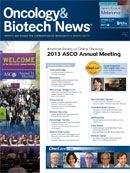CTC-Based Biomarkers Can Be Measured for Sensitivity to Novel Breast Cancer Drug
Biomarkers for sensitivity to etirinotecan pegol that are found in circulating tumor cells of breast cancer patients can be "reliably measured."
Hope Rugo, MD
Biomarkers for sensitivity to etirinotecan pegol (NKTR- 102) that are found in circulating tumor cells of breast cancer patients can be “reliably measured,” according to a subanalysis of the phase III BEACON trial.
In the study, the researchers were able to measure the expression of seven previously identified biomarkers for the effectiveness of etirinotecan pegol (EP). The drug is a topoisomerase 1 inhibitor designed for prolonged tumor cell exposure that demonstrated a 29% objective response rate in phase II trials and proved more effective than irinotecan in patients with metastatic breast cancer (mBC), according to first author Ute Hoch, PhD, and colleagues. Hoch, who presented the study in a poster session at the 2013 ASCO Annual Meeting, is the director of Clinical Pharmacology at Nektar Therapeutics, which is developing EP.
In the ongoing phase III randomized, open-label BEACON trial, patients with mBC are randomized to EP monotherapy or physician’s choice of single-agent treatment. Eligibility criteria include previous treatment with an anthracycline, a taxane, and capecitabine. The primary endpoint is overall survival.
Hoch et al conducted their separate analysis because BEACON also has an exploratory objective: the measurement of biomarkers for EP response in circulating tumor cells (CTCs) and tumor tissue. That approach is desirable because it is minimally invasive, the authors wrote.
“One of our objectives in treating metastatic breast cancer is to prospectively identify patients that will respond to specific treatments so they can achieve the optimal individualized care,” said Hope S. Rugo, MD, director of Breast Oncology and Clinical Trials Education at the UCSF Helen Diller Comprehensive Cancer Center and a member of the BEACON study investigator steering committee, in a statement released during the ASCO meeting. “The goal of evaluating these important biomarkers in patients enrolled into the BEACON study is to help us understand which breast cancer patients might have the best clinical outcomes from treatment with etirinotecan pegol.”
In the BEACON subanalysis, the investigators first created quantitative multiplex immunofluorescent assays capable of measuring target-specific pharmacodynamic biomarkers for EP in CTCs that were isolated pre- and posttreatment. In doing that, they used control and drug-treated tumor cells, along with samples from healthy patients for comparison.
The team went on to collect blood samples from 167 BEACON patients and isolate CTCs using dielectrophoresis field-flow fractionation. Once isolated, the CTCs were stained to detect biomarkers and then analyzed with an iCys laser scanning cytometer.
CTCs were detectable in 93% of the patient blood samples, the authors reported. They measured seven biomarkers for EP response in the pretreatment CTCs of the patients: TUNEL (93%), topoisomerase 2 (89%), topoisomerase 1 (82%), RAD51 (53%), Ki-67 (52%), ABCG2 (31%), and Ò¯-H2Ax (16%).
Because the median number of CTCs in the blood samples tends to be high, it will be possible to evaluate biomarkers in these patients over time, the authors wrote. Ultimately, the investigators expect that 75% of BEACON’s projected 840 patients will participate in the exploratory biomarker analysis.
The findings, the authors wrote, demonstrate that EP “target-specific pharmacodynamic biomarkers can be reliably measured in CTCs isolated from patients.”
Follow-up work, they said, will involve correlating and assessing the biomarkers for their potential to predict clinical response.
Hoch U, Fry DG, Chia YL, et al. Etirinotecan pegol target-specific pharmacodynamic biomarkers measured in circulating tumor cells (CTCs) from patients in the phase III BEACON study in patients with metastatic breast cancer (mBC). J Clin Oncol. 2013;31(suppl; abstr 1087).




